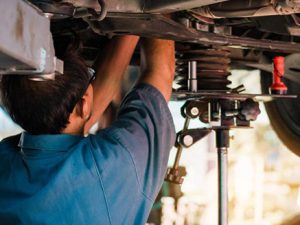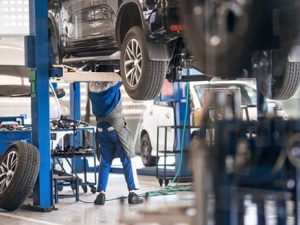A well-functioning suspension system is crucial for vehicle safety, comfort, and handling. If any part of your suspension system begins to fail, it can lead to a variety of driving issues, from poor handling and reduced comfort to dangerous instability. In this article, we will cover the key symptoms of suspension problems, their potential causes, and the best solutions for each issue. We’ll also include tables to help identify and diagnose common suspension problems quickly.
Key Symptoms of Suspension Problems

Suspension issues may manifest in various ways. Below is a table outlining common symptoms of suspension problems and their potential causes.
| Symptom | Possible Cause | Solution |
|---|---|---|
| Uneven Tire Wear | Misalignment or worn-out suspension components | Inspect alignment, replace worn-out suspension parts (e.g., control arms, bushings, struts) |
| Vehicle Pulls to One Side | Uneven suspension load or damaged suspension parts | Check for damaged springs, shocks, or sway bar; align the vehicle |
| Bouncy Ride or Excessive Body Roll | Worn shocks or struts | Replace worn shock absorbers or struts |
| Clunking, Rattling, or Grinding Noises | Worn bushings, ball joints, or loose suspension parts | Inspect and replace worn bushings, ball joints, or tighten loose parts |
| Difficulty Steering or Handling | Worn steering components, suspension misalignment | Check for worn control arms, steering linkage, or suspension parts |
| Vibrations or Steering Wheel Shaking | Damaged shock absorbers, broken struts, or tire imbalance | Inspect suspension components, balance tires, or replace damaged parts |
Common Causes of Suspension Problems
Suspension problems can arise from a variety of factors. Below is a table detailing some of the most common causes of suspension failure and their impact.
| Cause | Impact on Suspension | Preventive Measures |
|---|---|---|
| Driving on Rough Roads or Potholes | Accelerates wear on shocks, struts, and other suspension components | Avoid harsh driving, slow down on rough roads, regularly inspect suspension |
| Age and Prolonged Use | Natural wear and tear of components like bushings, springs, and shock absorbers | Replace worn-out components periodically based on vehicle age or usage |
| Overloading the Vehicle | Puts excess strain on suspension components | Avoid exceeding vehicle load capacity, especially when towing |
| Improper Vehicle Alignment | Leads to uneven wear and handling issues | Regularly check and align your vehicle, especially after suspension repairs or tire replacements |
| Corrosion or Exposure to Weather | Rust or deterioration of suspension components | Wash the undercarriage frequently, especially in regions with heavy road salt or extreme weather conditions |
| Faulty Installation or DIY Modifications | Components may not function properly or wear prematurely | Ensure professional installation and use appropriate parts for your vehicle model |
How to Diagnose Suspension Issues

Diagnosing suspension issues early can save you time and money by preventing more extensive damage. Here is a step-by-step guide to diagnosing common suspension problems:
| Step | Description | What to Look For |
|---|---|---|
| 1. Inspect the Tires | Check for uneven wear patterns or bulges. | Uneven tire wear, bald spots, or tire bulging may indicate suspension issues. |
| 2. Perform a Bounce Test | Push down on each corner of the vehicle to see how it reacts. | If the vehicle bounces more than once or twice, the shock absorbers are likely worn. |
| 3. Check for Leaks | Inspect the shock absorbers or struts for signs of fluid leaks. | If you see fluid around the struts or shocks, they may need replacement. |
| 4. Listen for Unusual Noises | Pay attention to any clunking, rattling, or squeaking sounds. | Worn bushings, ball joints, or loose suspension parts could cause these sounds. |
| 5. Test Steering and Handling | Drive the vehicle and test for steering responsiveness. | Difficulty steering or excessive body roll during cornering indicates suspension issues. |
| 6. Perform a Visual Inspection | Look for damage, cracks, or rust on suspension components. | Inspect control arms, sway bars, springs, and other parts for damage or corrosion. |
Common Suspension Parts and Their Functions
Understanding the key components of your suspension system can help you identify where a problem may lie. Below is a table of common suspension parts and their role in the system.
| Suspension Component | Function | Signs of Failure |
|---|---|---|
| Shock Absorbers | Control the rebound of the vehicle and prevent bouncing. | Bouncy ride, excessive body roll, or fluid leakage |
| Struts | Absorb shocks and help with vehicle stability. | Clunking sounds, poor handling, or uneven tire wear |
| Springs | Support the vehicle’s weight and absorb bumps. | Sagging vehicle height, bottoming out, or excessive body roll |
| Control Arms | Connect the suspension to the vehicle’s frame and allow for movement. | Clunking or knocking noises, difficulty steering, uneven tire wear |
| Ball Joints | Provide pivot points for steering and suspension movement. | Squeaking or popping noises, steering issues, uneven tire wear |
| Bushings | Cushion the connection between suspension components. | Squeaky noises, poor handling, or visible cracks |
| Stabilizer Bars | Reduce body roll during cornering by linking the suspension sides. | Excessive body roll, poor cornering stability |
Solutions for Common Suspension Problems
Once you’ve identified the issue with your suspension system, here’s a table outlining the most effective solutions for common problems.
| Problem | Solution | When to Apply |
|---|---|---|
| Bouncy Ride or Excessive Body Roll | Replace shock absorbers or struts | When shocks or struts are leaking or damaged |
| Clunking or Rattling Noises | Replace worn bushings, ball joints, or control arms | When there’s a consistent noise coming from the suspension |
| Uneven Tire Wear | Realign the vehicle or replace worn suspension parts | When tire wear is uneven or the vehicle pulls to one side |
| Poor Steering Response | Replace worn steering components or suspension parts | When steering feels stiff or unresponsive |
| Vibrations or Steering Wheel Shaking | Balance the tires, replace damaged shocks or struts | When steering wheel shakes, particularly at high speeds |
Conclusion
Regular inspection and timely repairs are essential to keeping your suspension system in optimal condition. Suspension problems, if left unaddressed, can lead to poor vehicle handling, compromised safety, and increased repair costs. By understanding the common symptoms, causes, and solutions for suspension issues, you can diagnose problems early and take appropriate action.
Always consult a professional mechanic if you are unsure about the diagnosis or repair process. Keeping your suspension system in top shape will not only improve your vehicle’s performance but also ensure a safer and more comfortable driving experience.